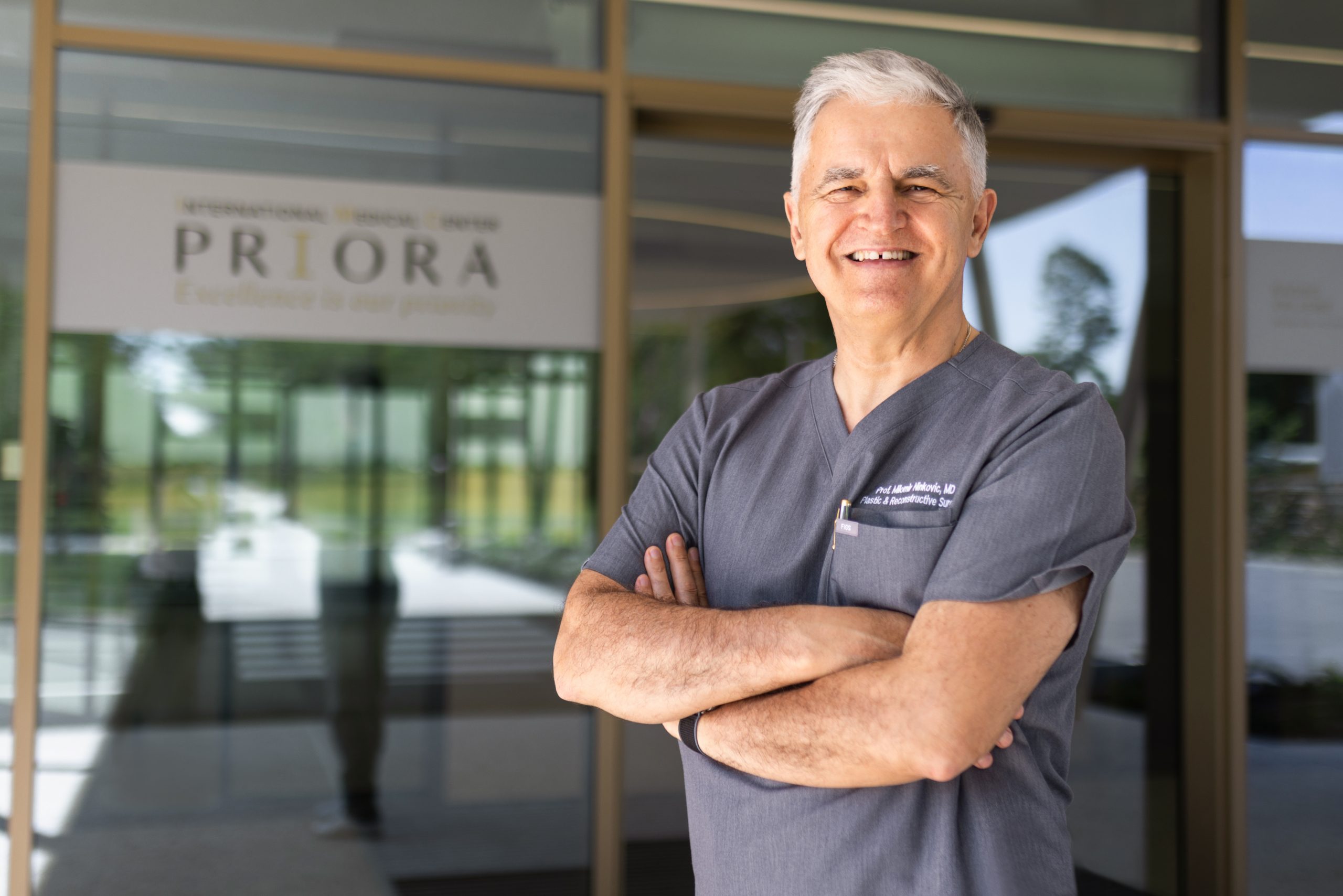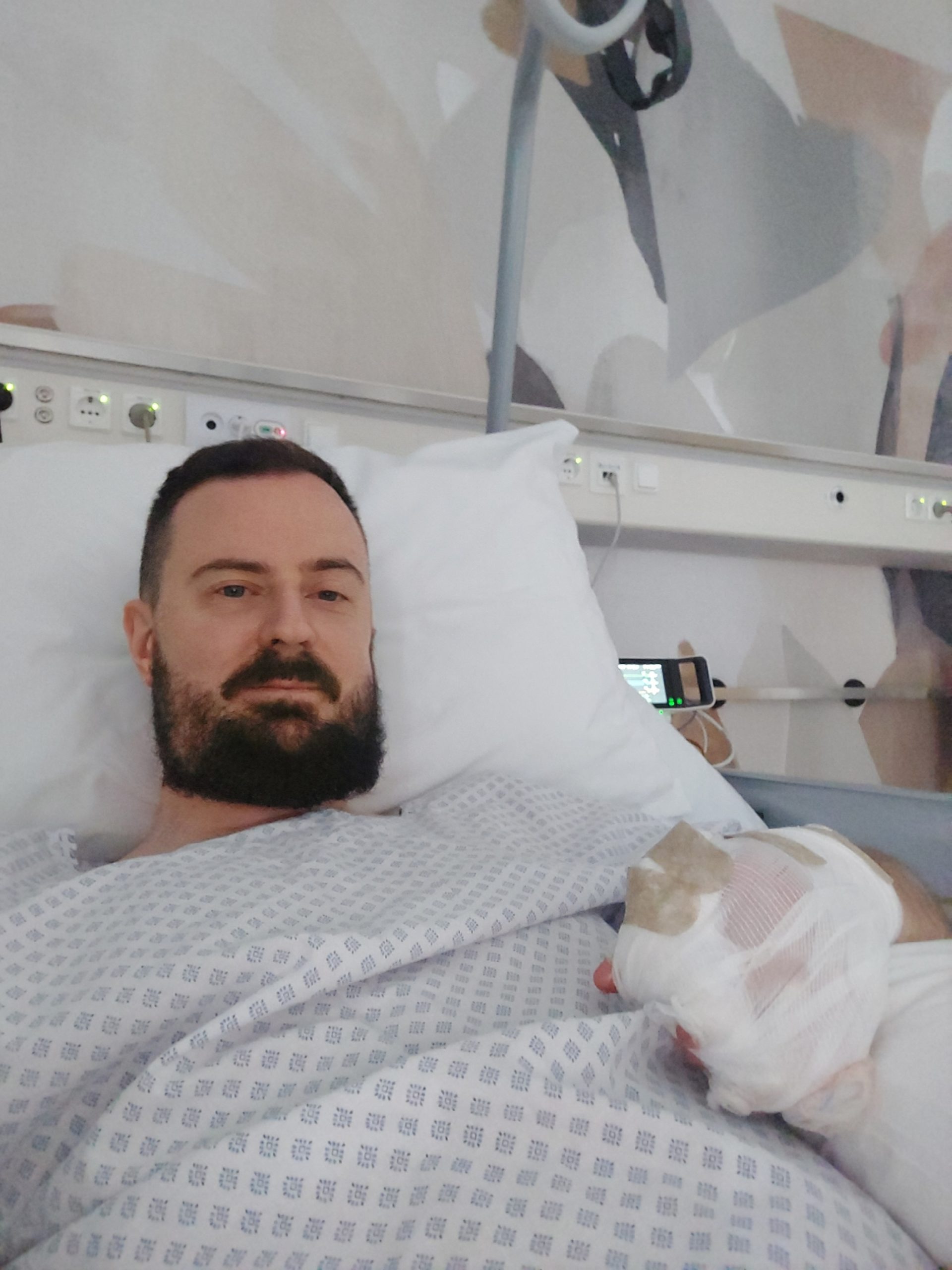The most visible signs of the disease in Mirza’s case are on his hands, where his fingers have almost completely fused. Last autumn, he underwent surgery at IMC Priora in Čepin, performed by Prof. Dr. Milomir Ninković.
Mirza Kahriman from Sarajevo is 38 years old and has lived with bullous epidermolysis since birth – a rare genetic disease that makes the skin and mucous membranes extremely fragile, resulting in blisters and open wounds. The skin is sensitive to the slightest pressure, and painful, burn-like sores appear easily.
In Mirza’s case, the most severe effects are on his hands, where his fingers have nearly fused. For that reason, he underwent surgery at the International Medical Center Priora in Čepin near Osijek, performed by Prof. Milomir Ninković, one of the world’s leading plastic surgeons.

When and how was bullous epidermolysis diagnosed?
“It’s a congenital condition that’s usually detected right after birth. During delivery, certain injuries can occur as the baby is being delivered. In my case, as with most so-called ‘butterfly children,’ one foot was visibly affected at birth. Based on that, and the appearance of several blisters, doctors immediately identified bullous epidermolysis.”
Does anyone else in your family have the same diagnosis?
“You can inherit bullous epidermolysis, but in my case, both of my parents are healthy – they’re just carriers of the mutated gene that causes improper development of the protein responsible for binding the skin layers together. When a child inherits the mutated gene from both parents, the disease develops, even though the parents themselves are unaffected.”
How does the disease manifest in your case?
“Bullous epidermolysis is a rare genetic disorder in which, due to a gene mutation, the body produces little or no collagen. This causes a separation between the epidermis and the dermis – the upper and lower layers of the skin. Since the ‘glue’ that should hold them together doesn’t function properly, friction causes the epidermis to peel away or form blisters. Over time, constant damage prevents the skin from regenerating, resulting in contractures—a permanent restriction of movement. The hands are always the most exposed and most severely affected because we use them constantly and they’re never protected by clothing.”
“There are three main types of this disease: simplex, junctional, and dystrophic. I have dystrophic bullous epidermolysis, fortunately, a milder form – my body still produces collagen, just not enough of it. As much as I struggle with my skin, my greater problem is the mucous membranes inside my body, especially a narrowed esophagus. And, of course, my hands are in deplorable condition.”
How did your fingers become fused?
“I wasn’t born with fused fingers, but over time, due to constant injuries and skin trauma, damage, and scarring occurred. As the skin gradually turns into scar tissue, it loses elasticity and becomes dystrophic. Contractures then develop – the hand grows, but the skin can’t stretch with it, and the fingers slowly fuse, curling into a closed position. My right hand is worse than my left, mainly because of the enormous amount of writing I did during school – my hand is literally closed in the shape of holding a pen.”

How do you cope with bullous epidermolysis?
“We are all mentally powerful people, probably because we toughen up from an early age. A lot depends on the parents – how they handle the diagnosis and how much they support the child’s growth into a person capable of living a fulfilling life. I’ve been through everything, but I completed a degree in psychology and now run our family herbal pharmacy. Through the Debra Association, which brings together people affected by bullous epidermolysis, I’ve met incredible individuals in both Bosnia and Croatia. No matter how difficult the illness, both children and adults share a strong spirit and optimism – they’re positive, witty, intelligent, and many are artistically gifted.”
What was your childhood like – were your peers understanding?
“I never had problems being accepted. I always had friends and was never excluded. Growing up in war-torn Sarajevo, we saw wounded people and disabilities every day, so maybe that made the children more understanding. Or maybe it’s just the spirit of Sarajevo – but I never had issues with being understood.”
Given that this is such a rare disease, how challenging is it to find specialists who can assist?
“It’s estimated that one in 50,000 people has bullous epidermolysis. Finding doctors who truly understand this condition and are willing to treat it seriously is incredibly difficult. Medical staff must be aware of every detail to prevent causing new wounds or additional complications. IMC Priora is the fourth hospital I’ve stayed in during my life. I’ve lost count of the examinations and procedures I’ve gone through in 38 years. I’ve been under general anesthesia more than 80 times, mostly because of esophageal issues. The disease shortens life expectancy – one of the biggest risks is skin cancer, which further weakens the already fragile body. During the COVID-19 pandemic, I developed skin cancer on my foot and had surgery in Sarajevo under local anesthesia, without sedation. A few months later, I noticed the beginning of a melanoma on my right leg – fortunately, it was caught in time. The stress led to severe anxiety and further narrowing of my esophagus. At times, I couldn’t swallow even a small pea. When food got stuck, I’d spend hours in agony. Thankfully, both my esophagus and anxiety are now under control.”
How did you learn that Professor Ninković could help you, and what procedure did you undergo at IMC Priora?
“Fourteen years after my last hand surgery, I decided to try again. The plastic surgery department in Sarajevo recommended that I look abroad, so I began exploring options across Europe. One of the biggest challenges for us is finding a hospital that can safely administer anesthesia. Intubation for patients with bullous epidermolysis is extremely delicate because our mouths and throats are so sensitive, and we can’t open our mouths wide. Traditional intubation isn’t possible; it must be performed using a specialized method with a fiber bronchoscope. Vlasta Zmazek, president of the Croatian Debra Association and a close family friend, recommended Prof. Ninković and IMC Priora, which was opening at the time.”

What was the procedure like?
“I’d already had my fingers separated four times before, but the results were poor – the grafts would fall off during the first dressing change, leaving the entire hand exposed, like one big wound. Healing took six months of agony, and the skin ended up even more damaged. Prof. Ninković approached my case in a completely different manner. He took the gracilis muscle, along with skin and fatty tissue, from my right thigh and transplanted it to the separated areas of my left hand. I was genuinely impressed by the entire medical team – not a single scratch, just professionalism, understanding, and a sincere desire to help. In our case, every small detail matters – from how they place a bandage to how they move you from one bed to another. Every wrong move means a new wound and another setback.”
How did you recover, and what is the condition of your hand today?
“I was in good condition immediately after surgery. The donor site on my leg healed within a week, and my hand is now almost fully healed. The thumb is beautifully separated, and nothing has refused. I’m already using my hand for work, and recently, I’ve even started driving again. I’ll continue with exercises to strengthen mobility and improve grip function.”